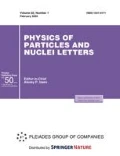Abstract
We review some fundamental aspects of mixed symmetry tensor gauge theories using a formulation based on graded geometry. In particular, we are able to construct kinetic, mass and Galileon-type higher derivative interaction terms for such fields. The resulting elegant geometric formulas allow for shared features of these theories to be highlighted and for possible interaction terms to be classified. In addition, we argue that this formalism is very useful in studying dualities. In particular, we construct a universal first order Lagrangian that may serve as the starting point for the off shell dualizations of differential form gauge theories and generalized gravitons.
Similar content being viewed by others
REFERENCES
A. Chatzistavrakidis, F. S. Khoo, D. Roest, and P. Schupp, “Tensor Galileons and gravity,” J. High Energy Phys. 1703, 070 (2017). https://doi.org/10.1007/JHEP03(2017)070
A. Chatzistavrakidis, G. Karagiannis, and P. Schupp, “A unified approach to standard and exotic dualizations through graded geometry,” Commun. Math. Phys. (2020). arXiv: 1908.11663 [hep-th]. https://doi.org/10.1007/s00220-020-03728-x
D. Lovelock, “The Einstein tensor and its generalizations,” J. Math. Phys. 12, 498 (1971). https://doi.org/10.1063/1.1665613
G. W. Horndeski, “Second-order scalar-tensor field equations in a four-dimensional space,” Int. J. Theor. Phys. 10, 363 (1974). https://doi.org/10.1007/BF01807638
A. Nicolis, R. Rattazzi, and E. Trancherini, “The Galileon as a local modification of gravity,” Phys. Rev. D 79, 064036 (2009). https://doi.org/10.1103/PhysRevD.79.064036
C. Deffayet, S. Deser, and G. Esposito-Farese, “Generalized Galileons: All scalar models whose curved background extensions maintain second-order field equations and stress-tensors,” Phys. Rev. D 80, 0640155 (2009). https://doi.org/10.1103/PhysRevD.80.064015
C. Deffayet, S. Deser, and G. Esposito-Farese, “Arbitrary p-form Galileons,” Phys. Rev. D 82, 061501 (2010). https://doi.org/10.1103/PhysRevD.82.061501
T. Curtright, “Generalized Gauge fields,” Phys. Lett. B 165, 304 (1985). https://doi.org/10.1016/0370-2693(85)91235-3
C. M. Hull, “Duality in gravity and higher spin Gauge fields,” J. High Energy Phys. 0109, 027 (2001). https://iopscience.iop.org/article/10.1088/1126-6708/2001/09/027
P. C. West, “E(11) and M theory,” Class. Quant. Grav. 18, 4443 (2001). https://doi.org/10.1088/0264-9381/18/21/305
P. de Medeiros and C. M. Hull, “Exotic tensor gauge theory and duality,” Commun. Math. Phys. 235, 255 (2003). https://doi.org/10.1007/s00220-003-0810-z
N. Boulanger, P. Sundell, and P. West, “Gauge fields and infinite chains of dualities,” J. High Energy Phys. 1509, 19 (2015). https://doi.org/10.1007/JHEP09(2015)1922
N. Boulanger, P. P. Cook, and D. Ponomarev, “Off-shell hodge dualities in linearised gravity and E11,” J. High Energy Phys. 1209, 089 (2012). https://doi.org/10.1007/JHEP09(2012)089
N. Boulanger, S. Cnockaert, and M. Henneaux, “A note on spin s duality,” J. High Energy Phys. 0306, 060 (2003). https://iopscience.iop.org/article/10.1088/ 1126-6708/2003/06/060
E. A. Bergshoeff, O. Hohm, V. A. Penas, and F. Riccioni, “Dual double field theory,” J. High Energy Phys. 1606, 026 (2016). https://doi.org/10.1007/JHEP06(2016)026
A. Chatzistavrakidis and G. Karagiannis, “Relation between standard and exotic duals of differential forms,” Phys. Rev. D 100, 121902(R). arXiv: 1911.00419 [hep-th]. https://doi.org/10.1103/PhysRevD.100.121902
M. Henneaux, V. Lekeu, and A. Leonard, “A note on the double dual graviton,” J. Phys. A 53, 014002 (2020). https://iopscience.iop.org/article/10.1088/1751-8121/ ab56ed
J. de Boer and M. Shigemori, “Exotic branes in string theory,” Phys. Rep. 532, 65 (2013). https://doi.org/10.1016/j.physrep.2013.07.003
F. Riccioni and P. C. West, “Dual fields and E(11),” Phys. Lett. B 645, 286 (2007). https://doi.org/10.1016/j.physletb.2006.12.050
P. P. Cook and P. C. West, “G+++ and brane solutions,” Nucl. Phys. B 705, 111 (2005). https://doi.org/10.1016/j.nuclphysb.2004.10.058
P. C. West, “E(11) origin of brane charges and U-duality multiplets,” J. High Energy Phys. 0408, 052 (2004). https://iopscience.iop.org/article/10.1088/1126-6708/2004/08/052
A. Chatzistavrakidis and F. F. Gautason, “U-dual branes and mixed symmetry tensor fields,” Fortsch. Phys. 62, 743 (2014). https://doi.org/10.1002/prop.201400023
A. Chatzistavrakidis, F. F. Gautason, G. Moutsopoulos, and M. Zagermann, “Effective actions of nongeometric five-branes,” Phys. Rev. D 89, 066004 (2014). https://journals.aps.org/prd/abstract/10.1103/PhysRevD. 89.066004
E. A. Bergshoeff and F. Riccioni, “String solitons and T-duality,” J. High Energy Phys. 1105, 131 (2011). https://doi.org/10.1007/JHEP05(2011)131
E. A. Bergshoeff and F. Riccioni, “D-brane Wess–Zumino terms and U-duality,” J. High Energy Phys. 1011, 139 (2010). https://doi.org/10.1007/JHEP11(2010)139
M. Alexandrov, A. Schwarz, O. Zaboronsky, and M. Kontsevich, “The geometry of the master equation and topological quantum field theory,” Int. J. Mod. Phys. A 12, 1405 (1997). https://doi.org/10.1142/S0217751X97001031
J. Qiu and M. Zabzine, “Introduction to graded geometry, Batalin–Vilkovisky formalism and their applications,” Arch. Math. 47, 143 (2011); arxiv:1105.2680.
P. de Medeiros and C. M. Hull, “Geometric second order field equations for general tensor gauge fields,” J. High Energy Phys. 0305, 019 (2003). https://iopscience.iop.org/article/10.1088/1126-6708/2003/05/019
C. Deffayet and D. A. Steer, “A formal introduction to Horndeski and Galileon theories and their generalizations,” Class. Quantum Grav. 30, 214006 (2013). https://iopscience.iop.org/article/10.1088/0264-9381/30/ 21/214006
C. Deffayet, G. Esposito-Farese, and A. Vikman, “Covariant Galileon,” Phys. Rev. D 79, 084003 (2009). https://doi.org/10.1103/PhysRevD.79.084003
ACKNOWLEDGMENTS
We are grateful to F.S. Khoo and D. Roest for collaboration in the part of this work that refers to tensor Galileons. A.Ch. and G.K. would also like to thank the organizers of the workshop “Supersymmetries and Quantum Symmetries—SQS’19”.
Funding
The work of A.Ch. and G.K. is supported by the Croatian Science Foundation Project “New Geometries for Gravity and Spacetime” (IP-2018-01-7615), and also partially supported by the European Union through the European Regional Development Fund—The Competitiveness and Cohesion Operational Programme (KK.01.1.1.06).
Author information
Authors and Affiliations
Corresponding authors
Rights and permissions
About this article
Cite this article
Chatzistavrakidis, A., Karagiannis, G. & Schupp, P. Graded Geometry, Tensor Galileons and Duality. Phys. Part. Nuclei Lett. 17, 718–723 (2020). https://doi.org/10.1134/S1547477120050106
Received:
Revised:
Accepted:
Published:
Issue Date:
DOI: https://doi.org/10.1134/S1547477120050106


